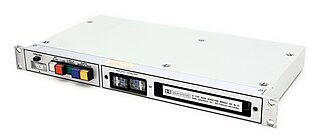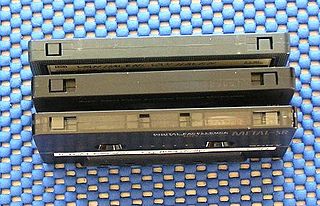Related Research Articles
An analog signal is any continuous signal for which the time-varying feature of the signal is a representation of some other time-varying quantity, i.e., analogous to another time-varying signal. For example, in an analog audio signal, the instantaneous voltage of the signal varies continuously with the pressure of the sound waves.

Tape bias is the term for two techniques, AC bias and DC bias, that improve the fidelity of analogue tape recorders. DC bias is the addition of direct current to the audio signal that is being recorded. AC bias is the addition of an inaudible high-frequency signal to the audio signal. Most contemporary tape recorders use AC bias.

An audio tape recorder, tape deck, or tape machine is a sound recording and reproduction device that records and plays back sounds usually using magnetic tape for storage. In its present-day form, it records a fluctuating signal by moving the tape across a tape head that polarizes the magnetic domains in the tape in proportion to the audio signal. Tape-recording devices include the reel-to-reel tape deck and the cassette deck, which uses a cassette for storage.

A Dolby noise-reduction system, or Dolby NR, is one of a series of noise reduction systems developed by Dolby Laboratories for use in analog audio tape recording. The first was Dolby A, a professional broadband noise reduction system for recording studios in 1965, but the best-known is Dolby B, a sliding band system for the consumer market, which helped make high fidelity practical on cassette tapes, which used a relatively noisy tape size and speed. It is common on high fidelity stereo tape players and recorders to the present day. Of the noise reduction systems, Dolby A and Dolby SR were developed for professional use. Dolby B, C, and S were designed for the consumer market. Aside from Dolby HX, all the Dolby variants work by companding, or compressing the dynamic range of the sound during recording and expanding it during playback.
A cassette deck is a type of tape machine for playing and recording audio cassettes. The consumer electronics industry formerly used the term deck to distinguish them from a tape recorder, the "deck" being part of a stereo component system, while a "tape recorder" was more portable and usually had a self-contained power amplifier.
Sound can be recorded and stored and played using either digital or analog techniques. Both techniques introduce errors and distortions in the sound, and these methods can be systematically compared. Musicians and listeners have argued over the superiority of digital versus analog sound recordings. Arguments for analog systems include the absence of fundamental error mechanisms which are present in digital audio systems, including aliasing and quantization noise. Advocates of digital point to the high levels of performance possible with digital audio, including excellent linearity in the audible band and low levels of noise and distortion.

Mastering, a form of audio post production, is the process of preparing and transferring recorded audio from a source containing the final mix to a data storage device, the source from which all copies will be produced. In recent years digital masters have become usual, although analog masters—such as audio tapes—are still being used by the manufacturing industry, particularly by a few engineers who specialize in analog mastering.

Reel-to-reel audio tape recording, also called open-reel recording, is the form of magnetic tape audio recording in which the recording medium is held on a reel that is not permanently mounted in an enclosed cassette. In use, the supply reel containing the tape is placed on a spindle or hub; the end of the tape is manually pulled out of the reel, threaded through mechanical guides and a tape head assembly, and attached by friction to the hub of the second, initially empty takeup reel.
Print-through is a generally undesirable effect that arises in the use of magnetic tape for storing analogue information, in particular music, caused by contact transfer of signal patterns from one layer of tape to another.

dbx is a family of noise reduction systems developed by the company of the same name. The most common implementations are dbx Type I and dbx Type II for analog tape recording and, less commonly, vinyl LPs. A separate implementation, known as dbx-TV, is part of the MTS system used to provide stereo sound to North American and certain other TV systems. The company, dbx, Inc., was also involved with Dynamic Noise Reduction (DNR) systems.

Noise reduction is the process of removing noise from a signal. Noise reduction techniques exist for audio and images. Noise reduction algorithms tend to alter signals to a greater or lesser degree.

A tape head is a type of transducer used in tape recorders to convert electrical signals to magnetic fluctuations and vice versa. They can also be used to read credit/debit/gift cards because the strip of magnetic tape on the back of a credit card stores data the same way that other magnetic tapes do. Cassettes, reel-to-reel tapes, 8-tracks, VHS tapes, and even floppy disks and modern hard drive disks all use the same principle of physics to store and read back information. The medium is magnetized in a pattern. It then moves at a constant speed over an electromagnet. Since the moving tape is carrying a changing magnetic field with it, it induces a varying voltage across the head. That voltage can then be amplified and connected to speakers in the case of audio, or measured and sorted into ones and zeroes in the case of digital data.

The 8mm video format refers informally to three related videocassette formats for the NTSC and PAL/SECAM television systems. These are the original Video8 format and its improved successor Hi8, as well as a more recent digital recording format known as Digital8.
The Digital Audio Stationary Head or DASH standard is a reel-to-reel, digital audio tape format introduced by Sony in early 1982 for high-quality multitrack studio recording and mastering, as an alternative to analog recording methods. DASH is capable of recording two channels of audio on a quarter-inch tape, and 24 or 48 tracks on 1⁄2-inch-wide (13 mm) tape on open reels of up to 14 inches. The data is recorded on the tape linearly, with a stationary recording head, as opposed to the DAT format, where data is recorded helically with a rotating head, in the same manner as a VCR. The audio data is encoded as linear PCM and boasts strong cyclic redundancy check (CRC) error correction, allowing the tape to be physically edited with a razor blade as analog tape would, e.g. by cutting and splicing, and played back with no loss of signal. In a two-track DASH recorder, the digital data is recorded onto the tape across nine data tracks: eight for the digital audio data and one for the CRC data; there is also provision for two linear analog cue tracks and one additional linear analog track dedicated to recording time code.

A noise gate or gate is an electronic device or software that is used to control the volume of an audio signal. Comparable to a compressor, which attenuates signals above a threshold, such as loud attacks from the start of musical notes, noise gates attenuate signals that register below the threshold. However, noise gates attenuate signals by a fixed amount, known as the range. In its simplest form, a noise gate allows a main signal to pass through only when it is above a set threshold: the gate is "open". If the signal falls below the threshold, no signal is allowed to pass : the gate is "closed". A noise gate is used when the level of the "signal" is above the level of the unwanted "noise". The threshold is set above the level of the "noise", and so when there is no main "signal", the gate is closed.

Sound recording and reproduction is an electrical, mechanical, electronic, or digital inscription and re-creation of sound waves, such as spoken voice, singing, instrumental music, or sound effects. The two main classes of sound recording technology are analog recording and digital recording.
Audio noise measurement is carried out to assess the quality of audio equipment, such as is used in recording studios, broadcast engineering, and in-home high fidelity.

The history of sound recording - which has progressed in waves, driven by the invention and commercial introduction of new technologies — can be roughly divided into four main periods:

Chromium dioxide or chromium(IV) oxide is an inorganic compound with the formula CrO2. It is a black synthetic magnetic solid. It once was widely used in magnetic tape emulsion. With the increasing popularity of CDs and DVDs, the use of chromium(IV) oxide has declined. However, it is still used in data tape applications for enterprise-class storage systems. It is still considered by many oxide and tape manufacturers to have been one of the best magnetic recording particulates ever invented.

Audio compact cassettes use magnetic tape of three major types which differ in fundamental magnetic properties, the level of bias applied during recording, and the optimal time constant of replay equalization. Specifications of each type were set in 1979 by the International Electrotechnical Commission (IEC). By this time, Type I included pure gamma ferric oxide formulations, Type II included ferricobalt and chromium dioxide formulations, and Type IV included metal particle tapes - the best performing, but also the most expensive. In the 1980s the lines between three types blurred. Panasonic developed evaporated metal tapes that could be made to match any of the three IEC types. Metal particle tapes migrated to Type II and Type I, ferricobalt formulations migrated to Type I. By the end of the decade performance of the best Type I ferricobalt tapes (superferrics) approached that of Type IV tapes; performance of entry-level Type I tapes gradually improved until the very end of compact cassette production.
References
- ↑ Ballou, Glen (2008). Handbook for Sound Engineers. Focal Press. p. 1060. ISBN 978-0-240-80969-4.
| This sound technology article is a stub. You can help Wikipedia by expanding it. |